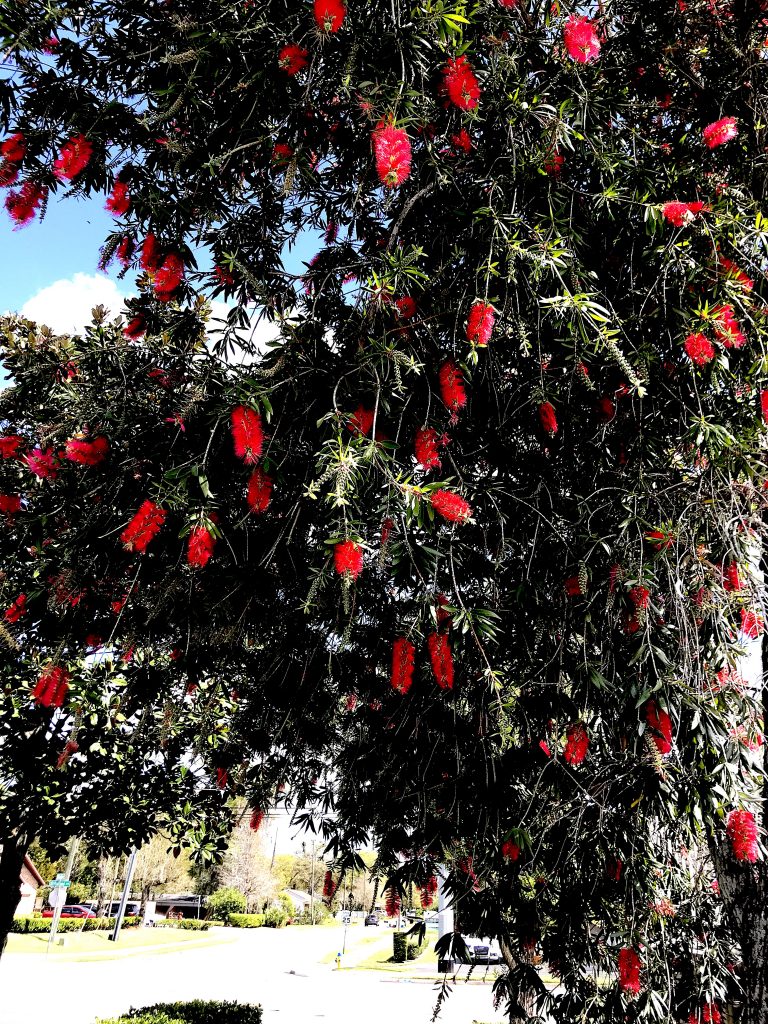
Bottlebrush Trees are happy now. Photo by Green Deane
The Greeks were perhaps the first people to call things what they were such as “yoke mate” for spouse or “shiny leather” for the Reishi mushroom. Then along came Latin that liked to be soft and flowery. English, conversely, is punchy and muscular. It gets to the point quickly. When you have a choice while writing always opt for English-based words over Latin-based ones. Extinguish The Conflagration doesn’t say it as well as Put Out The Fire! So when it came to a tree in which the leaves were used for tea it became the Tea Tree. And its oil became Tea Tree Oil with most folks forgetting the leaves can also be used for tea. The same down-to-earth approach was used with a very close relative to the Tea Tree, the Bottle Brush Tree, genus Callistemon. You can use the blossoms of the Bottle Brush Tree for tea or the leaves. The blossom tea tastes better and is slightly pink. Or, you can combine them. You can also use white Bottle Brush Tree blossoms for tea. By the way Latin was used for scientific names because it is a dead language that doesn’t change because no native population speaks it. To read about the Bottle Brush Tree go here.
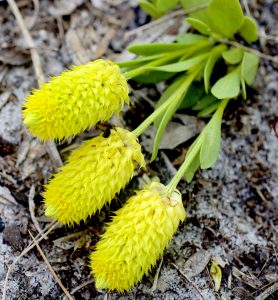
Candyroot and be yellow or orange, tall and short.
One gets used to seeing certain plants in certain places such as blueberries near oaks and pines. Dandelions also like acidic soil so they, too, can be found near oaks and pines. Lemon Bacopa (which tastes like lime) also seems to like specific places. I usually find it in the damp ruts of woods roads, or in damp spots on hiking trails, wet but sunny. Definitely not a suburban plant. I’ve actually found it in a body of water only once. Another site specific plant is Candyroot, pictured right. That, too, is often found along wood roads or paths that can be damp, either all the time or seasonally (that can be confusing. I have found Candyroot in wet places and places that are seasonally wet but mostly high and dry.) I saw a lot of it last week in the flood area of the St. Mary’s River in northeast Florida. In its tiny root it there is some methyl salicylate, smells like mint, birch, or checkerberries depending on your nose. It is a mild pain reliever. You can read about Candyroot here.
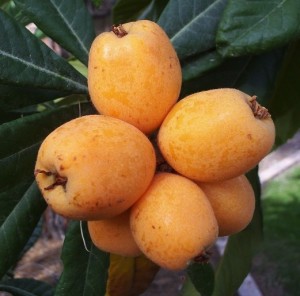
Loquats actually have a small amount of arsenic in them. Photo by Green Deane
An imported and naturalized tree that is fruiting a now is the Loquat. It’s a very common backyard fruit tree which has liberated itself into the landscape. Most of the Loquats locally fruit in the spring but there is a variation that fruits in the fall, not common. I have seen a lot of Loquats in fruit this season. While it is commonly called the “Japanese Plum” it is not a plum nor is it from Japan but it is in the greater rose family. The fruit is edible from tart yellow to sweet yellow. The green fruit is toxic particularly to children. You can read about the Loquat here.
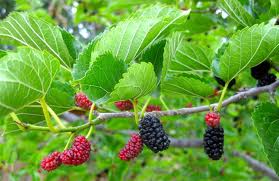
Mulberries are green now turning pink.
On a 40-mile bike ride recently I saw a few other plants worth mentioning. Red Mulberries are starting young, green fruit. The young leaves are edible cooked. The unripe green fruit is mildly mind-altering but will upset the stomach. Try not to eat them. Also seen along the bike trail are blossoming Blackberries. There are two kinds of Blackberries locally, those that grow canes and those that crawl along the ground. Both produce edible fruit in April. Also noticed along the trail are Maypops. They are not unusual, in fact very common. But until they get a foot long or so they grow upright and look like a vertical plant. But somewhere between 12 and 15 inches the plant keels over and becomes the familiar vine that can grow a hundred feet or so. And if one looks closely here and there one can also find some bird-missed Creeping Cucumbers.
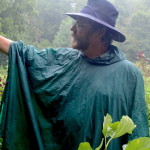
Classes are held rain or shine or cold…
Foraging Classes: One foraging class this weekend because of medical appointments. I am, after all, a septuagenarian. (It will take me a decade to get over that.)
Sunday, March 14th, Wickham Park, 2500 Parkway Drive, Melbourne, FL 32935-2335. 9 a.m. to noon. Meet at the “dog park” inside the park.
Saturday, March 20th, George LeStrange Preserve, 4911 Ralls Road, Fort Pierce, FL, 34981. 9 a.m. to noon. Meet in the parking lot.
Sunday, March 21st, Boulware Springs Park, 3420 SE 15th St., Gainesville, FL 32641. 9 a.m to noon, meet at the pavilion by the pump house.
Saturday, March 27th, Eagle Park Lake, 1800 Keene Road, Largo, FL 33771. 9 a.m. to noon. Meet at the pavilion near the dog park.
Sunday, March 28th, Mead Garden: 1500 S. Denning Dr., Winter Park, FL 32789. 9 a.m. to noon. The entrances is on the west side of the park on Denning.
Saturday, April 3rd, Florida State College, south campus, 11901 Beach Blvd., Jacksonville, 32246. 9 a.m. to noon. We meet at Building A next to the administration parking lot. Whether the bathrooms are open or not is always a problem at this location.
For more information on these clases, to prepay or sign up go here.

Green Deane videos are now available on a USB.
150-video USB would be a good spring present and is now $99. My nine-DVD set of 135 videos is being phased out. They are the same videos I have on You Tube. Some people like to have a separate copy. The USB videos have to be copied to your computer to play. They are MP4 files. My headache is getting my WordPress Order page updated to reflect this change. We’ve been working on it for several months. However, if you want to order the USB make a $99 “donation” using the link at the bottom of this page or here. That order form provides me with your address, the amount — $99 — tells me it is not a donation. Please include a snail-mail address.
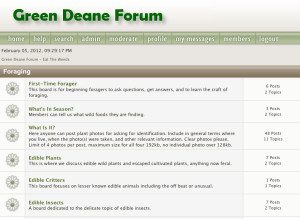
Green Deane Forum
Want to identify a plant? Perhaps you’re looking for a foraging reference? You might have a UFO, an Unidentified Flowering Object, you want identified. On the Green Deane Forum we — including Green Deane and others from around the world — chat about foraging all year. And it’s not just about warm-weather plants or just North American flora. Many nations share common weeds so there’s a lot to talk. There’s also more than weeds. The reference section has information for foraging around the world. There are also articles on food preservation, and forgotten skills from making bows to fermenting food.
This is weekly newsletter #448 If you want to subscribe to this free newsletter you can find the sign-up form in the menu at the top of the page.
To donate to the Green Deane Newsletter click here.


I plan on joining you for the edible hike on 3/27/21 at Eagle Lake Park.